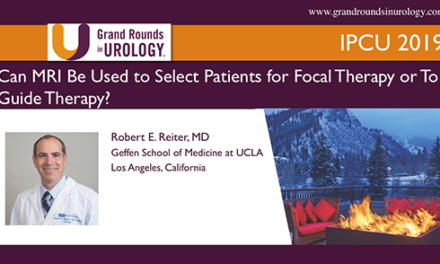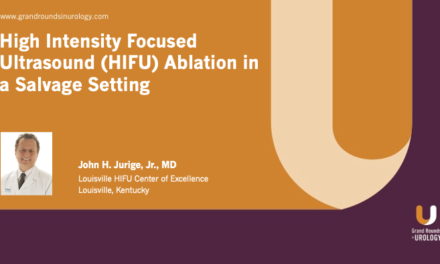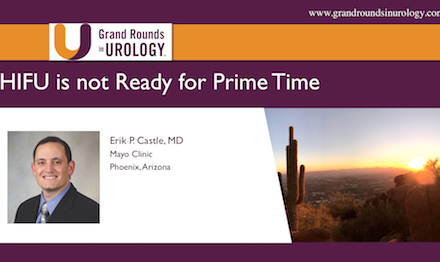Keywords: prostrate cancer, development drugs, private practice, regulations
How to cite: Karsh, Lawrence I. “The Future of Clinical Research in Private Practice: Alive or Dead?”. Grand Rounds in Urology. January 23, 2016. Dec 2024. https://dev.grandroundsinurology.com/prostate-cancer-lawrence-karsh-future-of-clinical-research-in-private-practice/.
The Future of Clinical Research in Private Practice: Alive or Dead? – Edited Transcript
Today, I am going to discuss if clinical research in private practices is alive or dead.
In 1632, Shah Jahan commissioned the Taj Mahal in Agra, India as a mausoleum for his third and favorite wife after she died giving birth to their fourteenth child. This beautiful building took twenty years to build. Reportedly, Shah Jahan severed the hands of the architect so that he could not duplicate the Taj Mahal in any other form.
After two years of building (rather than twenty), we are celebrating our tenth year of existence at our outpatient clinic, which we affectionately call the “Urog-mahal of Colorado.” We have a robust research department and offer radiation therapy, imaging, pathology, and surgery. Our architect is currently living, with his hands, in Boulder, Colorado. We deviated from the course of the Shah.
My research department consists of six people for whom I am immensely grateful. If it weren’t for their efforts, we could not accomplish what we do. I have a recruiter, four full-time coordinators, and a manager who doubles as a coordinator. Also, I am grateful for my partners for their support. Throughout my career, I have been the principal investigator in over 200 trials.
Our mission statement is: “Conduct clinical research with the utmost integrity and honesty while offering our patient subjects the most advanced therapies in addition to educating them about their disease. In so doing, we will protect their health, safety, and confidentiality.”
I am a strong proponent of research and development; I strongly believe that research and development are critical to the success of any business, whether you are in the medical field or not.
If you are not currently doing trials, I would strongly suggest that you become an investigator. I became an investigator because it presents an intellectual challenge. It keeps you aware of new technology, and you can offer new options to patients that have no alternative treatments. Also, your stature amongst peers and your community is strengthened as you conduct speaking assignments, serve on advisory boards, and act as a consultant to the industry. Not only does it provide additional revenue to your practice; it is also a pathway to publication and a method of promoting research as a new service in your practice. Finally, it can also prevent burnout.
Unfortunately, physician burnout is on the rise, and urologists are no exception. Although it feels like I work two full-time jobs, I yearn to solve problems in our trials; this research prevents burnout because it is fun and challenging.
In a study conducted by the Mayo Clinic, 7,000 physicians were interviewed—two percent of which were urologists—to analyze physician burnout. From 2011 to 2014, the prevalence of burnout amongst urologists has risen, from 41% to 64%. In 2011, urologists were ranked as the 15th most-satisfied specialists of 24 specialists surveyed, and then were ranked as the 23rd most-satisfied specialists in 2014. Physicians are facing an increase in work hours, less reimbursements, ongoing regulations, changes in Electronic Medical Records (EMR), and a multitude of other challenges. It is not surprising that burnout is rising and satisfaction is declining.
The Institutional Review Board (IRB), the sponsor, the investigator, and the subject are the key stakeholders in clinical trials. Although I will not talk about each of these individually, I will discuss the regulatory environment. The pharmaceutical industry is regulated by these authorities in each stage of development, including “good” laboratory practices, “good” manufacturing practices, and “good” clinical practices. I have questioned why they use the term “good” rather than “excellent”; perhaps “good” is sufficient for the government.
The FDA assures the safety and rights of subjects in trials and drug development. They issue regulations and guidelines, assure quality and integrity of data, and give input into the design of each clinical program and its protocols. Also, they assure that each clinical trial’s materials are high quality. Most important to the clinical trial are the investigator and the patient. If the investigator is the heart of the clinical trial, the patient is the soul. As practitioners, we are concerned about the patient’s safety and well-being, and we strive to improve their condition through the therapy that we provide.
There are many keys for success, such as business acumen, scientific curiosity, the right staff, infrastructure, and a portfolio of clinical trials. Most importantly, you must be motivated and dedicated to doing these trials. Eventually, you will build up a commendable portfolio of trials.
In order to be a successful investigator, one must have a clear understanding of what sponsors, regulators, IRBs, monitors, and the FDA expect.
In the clinical primer that I wrote, “A clinical trial primer: Historical perspective and modern implementation”, I discuss the mechanics of beginning clinical trials. If you search on Google, you can find papers that are better written and more detailed. There are four phases of clinical development. Phase I encompasses small trials that have the purpose of identifying side effects and evaluating safety for patients in small groups. If a drug successfully passes through that, then it goes on to Phase II, in which a larger trial is conducted. This determines the effective treatment and possible dosage while further evaluating safety. Then, there is the pivotal or registration Phase III trials; in these trials, you can get approval for these drugs. These trials involve anywhere from 500 to more than 1000 patients, depending on the statistical power needed to meet the endpoints of safety, efficacy, and comparison with other like drugs. Lastly, Phase IV studies are post-marketing studies. They review safety data and look at other indications that they can use. The Code of Federal Regulations does not dictate who is allowed to complete these studies. Depending on your capability as a community or academic site, you can do any of these phase studies.
The schema of drug development, which begins with discoveries from animal and in vitro testing, is followed by an investigational new drug application, and then transitions into clinical trials. If the drug passes Phase I through Phase III, an application for the new drug will be sent to the FDA. These are the different regulatory processes that go on through these different stages and phases.
It takes approximately 100,000 compounds and up to 12 years to develop a drug that gets to market. In 2003, the cost of this was about $802 million. Now, the Tufts Center for Study of Drug Development has estimated that the cost has skyrocketed; it costs about $2.6 billion to bring a drug to market. This strikes up a controversy. Does it really cost $2.6 billion to develop a drug? In a 2014 report, the Tufts Center claims that it does cost that much to develop a drug, but there is push back from many consumer organizations, such as Doctors Without Borders. They allege that the Tufts Center and a pharmaceutical company were in collusion to show high prices so they can justify the cost of drugs. However, the report only offered an analysis; it was not trying to justify the cost of drugs. Naturally, grants were given by pharmaceutical companies to complete this report, but they also want to know how much it costs them to do these trials. Who pays for all of this? Is it the public or private sector?
In a White Paper published in 2015, the Tufts Center discussed contributions to drug research and development. The government and BioPharma investments are highly complementary. During the basic research phase, the National Institutes of Health (NIH), or public sector, supplies most of the funding. Once it gets to the clinical research phase, the pharmaceutical companies spend more on that. The estimated NIH budget is $31 billion a year. They spend about $3 billion on their campus in Bethesda, but they give grants to institutions around the world. The private sectors spends $51 billion on research.
This debate goes back and forth, and new issues frequently surface. Above, I outlined what the public and private sectors pay for, but there are also additional costs. There are capital costs from having money invested in research for years. The largest cost is failure. Only 12% of drugs, or one in eight, that make it through the entire Phase III process actually succeed.
In addition, because there are so many drugs, especially in oncology, the comparators for these new drugs (the standard of care therapies) are very costly. If you are comparing enzalutamide to abiraterone, or you happen to use a comparator, that’s going to be very expensive.
Some of the industry challenges and frustration with academic centers come from the slow pace at which academic centers review proposals. When I talk to academicians, they’re frustrated with their own centers because of all the red tape. In the private world, we can get approval through a central IRB in about two to four weeks. It could take six months or longer, even up to a year, to get the approval through their institution. Every institution has their own individual IRB that has to approve decisions. Academic centers have delays in enrollment, competing priorities, and there’s a feeling that they have no sense of urgency.
Pharmaceutical companies have shifted to community physicians because we can review proposals and contracts faster. We recruit patients rapidly, our trial costs are low, and we have a diverse base of patients. To the industry, time is money. Patents are expiring; the minute they identify that compound, the clock is ticking.
Regardless of these challenges, industry, investigators, and patients can benefit through more collaboration between the academic and private sectors. We are discovering this as we work in cooperative groups with the Society of Urologic Oncology (SUO) in the Clinical Trials Consortium (CTC). When private community investigators and academicians work together, we can do so in harmony. Raoul S. Concepcion and Neal D. Shore head the CUSP organization, which really brings together many of these large group practices that do research. We’re trying to be more efficient; it’s really been a great organization to be part of.
The working groups that I will discuss have been critical in creating recommendations of endpoints and outcomes for clinical drug development for metastatic castration-resistant prostate cancer.
When PSA was developed, it was really an intermediate endpoint. There have been no drugs approved on PSA alone because it’s not a true surrogate marker. Because PSA is elevated in the majority of patients with advanced prostate cancer, and anecdotal evidence suggests that changes in PSA often antedated changes on bone scans, several groups have proposed the use of post-treatment changes in PSA to rapidly screen the activity of novel agents for the treatment of advanced prostate cancer.
The first one was reported in 1989 by Farrow, and many studies followed. However, they all used different post-treatment PSA parameters, so this limited cross-trial comparisons. Ultimately, it created confusion about further developing compounds or agents.
In response to this issue, the PSA Working Group formed a panel of experts that convened in March 1999. This panel consists of 20 notable medical oncologists; you’ll recognize all their names. They formed this panel in order to standardize Phase II trials for castration-resistant prostate cancer (CRPC) and formulate recommendations to allow clinical investigators to “speak the same language.” As stated previously, post-treatment PSA decline did not meet their criteria for a true surrogate marker, but PSA was still considered a valuable aid in screening therapies to move forward. The PSA Working Group recommendations set the stage for the development of a new generation of clinical trials in advanced prostate cancer.
In 1985, we had luteinising hormone-releasing hormone (LHRH) agonists; when the PSA Working Group assisted drug development in 1999, three drugs were approved in that time period. They were zoledronic acid, docetaxel, and degarelix. Those trial designs were done under some of the recommendations from the PSA Working Group.
Other agents were also tested, but they were not approved. It is possible that there were flaws in the trial design or that they did not have the correct clinical endpoints because some of these agents were efficacious.
The rejection of atrasentan and satraplatin led to the formation of the Prostate Cancer Working Group (PCWG) in 2008. They recommended a shift in emphasis from reliance on post-treatment changes in PSA to time-to-event endpoints. There was a proposal for 12 weeks of treatment with investigational products to ensure adequate exposure to a novel therapy. Many times, these agents were being tested, then at 12 weeks there would be some progression on a scan, and they’d say the treatment failed; it wasn’t going to meet an endpoint. Therefore, they were stopped prematurely.
Also, there was a requirement for two new bone lesions to qualify for disease progression and then, confirmation on bone scan to rule out things like tumor “flare” and nonspecific scan changes.
Since the PSA Working Group 2 met in 2008, six new drugs have been approved. It was under these guidelines of clinical trial design that they were able to be approved. Five out of six of these were approved on overall survival rates. I’m proud to say that in our clinical trials, we worked with about 4 out of these 6 in moving these things forward; we contributed to that.
Now that there are drugs that are approved on overall survival rates, it is difficult to get new drugs approved since there are such high expectations.
The PSA Working Group has met to update the guidelines and criteria that were set forth by PCWG2. Due to new developments, new agents, the identification of new disease phenotypes, and an evolving regulatory environment, there is a need to change the recommendations made at the American Society of Clinical Oncology (ASCO) meeting in May 2015. They had 8 face-to-face meetings over a 3-year period to decide on endpoints and criteria. They arrived at consensus criteria based on available new treatments and disease manifestations as well as data-validating biomarkers that were proposed in prostate cancer by PCWG2. The revised criteria defined the endpoints for M0 to M1 transition. These recommendations will help guide us in designing therapeutics to test in both M0 and M1 patient populations.
Although they convened in May 2015, we have three new agents that came out later the same year. Many of the PCWG2 members were on advisory committees for designing these trials. They are focusing on AR antagonists in development for M0. Some of these trials started in 2014. They’re still accruing, so we have ARN-509, ODM-201, and even enzalutamide, which was MDB-3100.
Currently, we are looking at the following combination trials. We are considering ARA and androgen biosynthesis inhibitors for the M1 population, and combinations in the JNJ-3001, which is a combination of Abi +/- ARN-509. Then, in a cooperative group, the ALLIANCE study is considering enzalutamide +/- Abi. In the future, we might get some answers as to whether or not combination trials are important. There’s another drug that’s being developed right now, galeterone, which is purported to be a 3-in-1. It’s a small molecule that has an androgen receptor antagonist capability, androgen biosynthesis inhibition, and the capability to degrade the receptor itself. It’s going to be exciting to see what results.
The PROSPECT trial, another vaccine for immunotherapy, closed earlier this year. They had 1,200 patients; we will need to see what results from their discoveries.
For 2016 and beyond, we have immunotherapies, which are very exciting. Now, with some of these recommendations for PCW-3, we have serial biologic profiling of tissue and blood. Hopefully, predictive biomarkers will surface, resulting in the sequencing of some of these drugs.
I would argue that the future of clinical research in private practice is alive and thriving. Collaboration between community and academic sites will move us closer to our goal of finding the safest, most effective therapies for our patients. Community practitioners should consider clinical research as an opportunity to expand their careers and benefit their patients. However, you must have a solid understanding of what regulators, sponsors, monitors, the IRB, and the FDA expect.
ABOUT THE AUTHOR
Lawrence I. Karsh, MD, is a Co-Founder of The Urology Center of Colorado, where he serves as an attending urologist and Director of Research & Co-Chairman of the Advanced Therapeutic Clinic. He is a certified principal investigator, and has been the principal investigator on over 250 clinical trials. He has authored a number of peer-reviewed publications and serves on the editorial boards for Oncology Live, Urologists in Cancer Care, and Bladder Cancer. He is a fellow of the American College of Surgeons, and an active member of the AUA, SUO, ASCO, SWOG, ACS, and the Denver Academy of Surgeons. He has served on the bladder cancer subcommittee and the advisory board for the SUO Clinical Trials Consortium and is a member of the Bladder Cancer Advocacy Network (BCAN) Think Tank.
Dr. Karsh completed his general surgery training at the University of Colorado Health Sciences Center (UCHSC) and his urology residency at Brigham and Women’s Hospital/Harvard Medical School. He is an Associate Clinical Professor of Surgery at UCHSC. Dr. Karsh participates in many advisory boards for new drug development. He lectures and teaches at scientific meetings throughout the country.





